September 30, 2009
"An Inconvenient Truth About Renewable Energy: It Can Sometimes Demand a Huge Amount of Water"
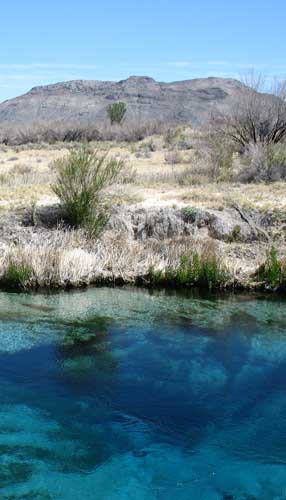
The New York Times went to Amargosa Valley in Nevada to cover the Solar Millennium story (>>here) in a piece titled "Alternative Energy Projects Stumble on a Need for Water."
<Ash Meadows springs, 30 miles from the Solar Millennium project site.
"Now Solar Millennium finds itself in the midst of a new-age version of a Western water war. The public is divided, pitting some people who hope to make money selling water rights to the company against others concerned about the project’s impact on the community and the environment."
"At public hearings from Albuquerque to San Luis Obispo, Calif., local residents have sounded alarms over the impact that this industrialization will have on wildlife, their desert solitude and, most of all, their water.
"Joni Eastley, chairwoman of the county commission in Nye County, Nev., which includes Amargosa Valley, said at one hearing that her area had been “inundated” with requests from renewable energy developers that “far exceed the amount of available water.”
The problem with solar thermal projects is wet cooling, where super-heated water flows through cooling towers and the excess heat evaporates along with some of the water, which must be replenished constantly. The only alternative, dry cooling, uses fans and heat exchangers in giant towers. Far less water is consumed, but dry cooling adds costs and reduces efficiency — and profits.
"Water disputes forced Solar Millennium to abandon wet cooling for a proposed solar trough power plant in Ridgecrest, Calif., after the water district refused to supply the 815 million gallons of water a year the project would need."
“'We will not do any wet cooling in California,' said Rainer Aringhoff, president of Solar Millennium’s American operations. 'There are simply no plants being permitted here with wet cooling.'”
Solar Millennium is vague about water use in its applications to the California Energy Commission regarding its two other California desert projects, in Desert Center and Blythe, both in Riverside County. We will be watching.
September 28, 2009
10,000-acre Photovoltaic Project Around Big Dune, Nevada, to be Announced

Bureau of Land Management told us recently that a Notice of Intent will be coming out in a week or so announcing a 10,000-acre photovoltaic panel renewable project in Amargosa Valley, Nye County, north of, and surrounding, Big Dune. The dunes are currently managed as an off-highway recreation area, and an Area of Critical Environmental Concern for several rare sand beetles sits on its northern edge.
When asked about the windshield-wrecking sand storms that frequent the area, we were told the solution will be to plant rows of trees around the PV field to block sand. We were not told how much water will be required to maintian these tree plantings.
The cumulative impacts of Big Solar projects in the desert are becoming evident.
We will watch this story closely -- stay tuned.
September 23, 2009
BrightSource Expands Plan for Solar Project at Coyote Springs, Nevada

BrightSource Energy, based in Oakland, California and Jerusalem, Israel, says it will expand its solar tower thermal plant planned for Coyote Springs to be more than a third larger than originally envisioned, to 960 megawatts. The site is 55 miles northeast of Las Vegas, a 43,000-acre master-planned community in the midst of the east Mojave Desert in Lincoln and Clark Counties, millionaire developer Harvey Whittemore's dreamchild. Part of the electricity generated would go to California. Because of difficulties in securing enough water, BrightSource plans to make the plant dry-cooled, which would use about 67 million gallons of water per year. That comes out to about 74,000 gallons of water for every megawatt generated. Wet-cooled solar thermal power plants use up to 2.6 million gallons for each megawatt. Solar photovoltaic plants use about 16,700 gallons to produce one megawatt.
Environmentalists had criticized Whttemore's plans to use groundwater for 150,000 houses and a golf course, but have been more quiet about his deal to make a water-intensive renewable energy power plant.
Story in the Las Vegas Sun >>here.
See photos of the area on Desert Survivor Blog >>here.
September 18, 2009
Broadwell Dry Lake Solar Project Scrapped by BrightSource
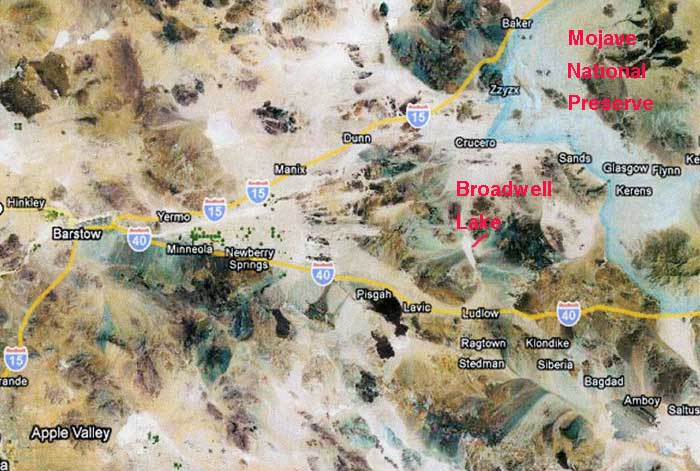
BrightSource Energy Inc. dropped its plans to build a solar project on 5,130 acres of Mojave Desert at Broadwell Dry Lake, San Bernardino County, California, as Sen. Dianne Feinstein (D-Calif.) pushed to designate the area into a national monument along historic Route 66 that parallels Interstate 40 (see our story >>here). The site lies east of the Cady Mountains Wilderness Study Area, on the other side of which, another solar project is still in the permitting stage: the SES Solar 1 project next to Pisgah. Both areas have equally valuable natural resources: bighorn sheep herds, rare plants, and reptiles adapted to match the color of dark volcanic rocks.
David Myers, executive director of the Wildlands Conservancy, raised $40 million to buy the old Catellus railroad lands that lie in both areas, and across the central Mojave, to protect them from development.
We wait to see if the area west of the Cady Mountains will also be protected, or a keyhole in a new park.
Story in the Los Angeles Times >>here.
September 10, 2009
BrightSource Partners With Bechtel for Ivanpah Solar Power Tower

^Project site in Ivanpah Valley.
BrightSource Energy Inc. has selected Bechtel as the engineering, procurement and construction (EPC) contractor for the Ivanpah Solar Electricity Generating System. The two companies also announced that Bechtel Enterprises, the project development and financing arm of the Bechtel organization, will become an equity investor in all of the Ivanpah solar power plants.
The power generated from these solar plants will be sold under separate contracts established by BrightSource Energy with Pacific Gas & Electric (PG&E) and Southern California Edison (SCE).
Though the cost of the project was not disclosed, Nathaniel Bullard, a solar analyst at the market research firm New Energy Finance, estimated that a solar thermal power plant of Ivanpah's size would cost about $2 billion to build
Story in New York Times >>here, and Renewable Energy World website >>here.
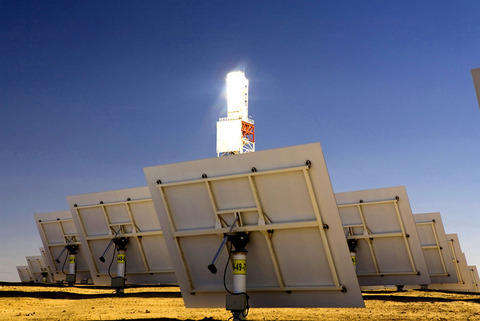
^BrightSource demo power tower.
August 28, 2009
Solar Millennium Responds to Town Over Water and Fire Concerns
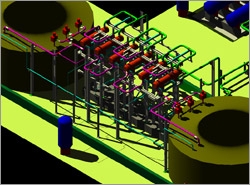 Solar Millennium responded to concerns from residents of the town of Amargosa Valley, Nevada, after a scoping meeting that took place over plans to build a large wet-cooled parabolic trough solar plant with thermal storage capability, right next to the town's school, senior center, church, park, and many farms and homes.
Solar Millennium responded to concerns from residents of the town of Amargosa Valley, Nevada, after a scoping meeting that took place over plans to build a large wet-cooled parabolic trough solar plant with thermal storage capability, right next to the town's school, senior center, church, park, and many farms and homes.
Concerns were raised about the large amount of groundwater needed by the solar project to cool its steam turbine cycle in this arid desert next to Death Valley National Park.
Solar Millennium said it would purchase existing irrigation water rights from alfalfa farmers. Senior Project Development Advisory Don Reid said, "We're not going to increase pumpage. We're going to grow megawatts instead of alfalfa."
Solar Millennium will require 4,600 acre-feet of water per year. Death Valley National Park hydrologist Richard Friese said the state engineer's office determined only 7,000 acre-feet of water per year is available for development in the Amargosa Desert Hydrographic Basin, with current groundwater withdrawals of 15,000 acre feet.
Jason Paul Higgins, Solar Millennium director of project development and permitting, said his company was notified by the state engineer's office that 25,000 acre feet of water is available in Amargosa Valley, of which about 18,000 acre feet, 75 percent of the yield, has been pumped.
We called the state engineer's office and were told that the Amargosa Basin's groundwater is overdrawn.
Responding to Amargosa Valley residents who pointed out the explosion at a similar solar plant with thermal storage at Daggett, California, in 1999, Reid said that plant was using Caloria oil as a heat transfer fluid and heat storage medium. The fire started in one of the thermal storage tanks filled with Caloria. Reid said Solar Millennium's thermal storage tanks will use molten salt, which is not flammable.
Reid, and the newspaper, failed to note that Solar Millennium's Amargosa Farm Road project will still be using a heat transfer fluid, a synthetic oil with the brand name Therminol, which has similar characteristics to Caloria when heated too high, causing vaporization that if accidentally sparked, could flame up. We talked to Don Reid at Solar Millennium's open house in May, and he explained how Therminol will be used in the pipes all across the mirror field (which will be approximately one and a quarter miles from the elementary school), to gather heat reflected from sunlight; this oil will then transfer the heat to molten salt in the two storage tanks in the center of each mirror field. If pipe breaks occur, this oil will still be dangerously close to houses and community structures. (No smoking!)
Reid told us, in the future the company hopes to experiment with molten salt in the pipes as well as in the storage tanks, but at this point that was not feasible.
Greg Helseth, Bureau of Land Management Renewable Energy Coordinator, told us that the military would have concerns over dry-cooling towers, which are tall, if not enough water was available for a wet-cooled system. The military also had its own concerns over sonic booms from flights bursting mirrors on a neighboring solar project. Nellis Air Range lies less than 20 miles to the east of Amargosa valley.
Story in the Pahrump Valley Times >>here.
From the National Renewable Energy Laboratory (www.nrel.gov):
Thermal Energy Storage Systems
Two-Tank Direct
The first Luz trough plant, SEGS I, included a direct two-tank thermal energy storage system with 3 hours of full-load storage capacity. This system simply used the mineral oil (Caloria) heat transfer fluid (HTF) to store energy for later use. It operated between 1985 and 1999 and was used to dispatch solar power to meet the Southern California Edison winter evening peak demand period (weekdays between 5-10 p.m.).
Because power plants later moved to higher operating temperatures for improving power cycle efficiency, they also switched to a new higher temperature heat transfer fluid—a eutectic mixture of biphenyl-diphenyl oxide (Therminol VP-1 or Dowtherm A). Unfortunately, this fluid has a high vapor pressure. Therefore, it cannot be used in the same type of large unpressurized storage tank system similar to the one used for SEGS I.
Pressurized storage tanks are very expensive. They cannot be manufactured at the large sizes needed for parabolic trough plants.
Two-Tank Indirect [Solar Millennium plan]
In recent years, a new indirect thermal energy storage (TES) approach has been developed. This approach takes advantage of the experience with the storage system used in the Solar Two— a molten-salt power tower demonstration project—and integrates it into a parabolic trough plant with the conventional heat transfer fluid through a series of heat exchangers.
The thermal energy storage system is charged by taking hot, heat transfer fluid (HTF) from the solar field and running it through the heat exchangers. Cold molten-salt is taken from the cold storage tank and run counter currently through the heat exchangers. It's heated and stored in the hot storage tank for later use. Later, when the energy in storage is needed, the system simply operates in reverse to reheat the solar heat transfer fluid, which generates steam to run the power plant.
Direct Molten-Salt Heat Transfer Fluid
Using molten-salt in both the solar field and thermal energy storage system eliminates the need for expensive heat exchangers. It allows the solar field to be operated at higher temperatures than current heat transfer fluids allow. This combination also allows for a substantial reduction in the cost of the thermal energy storage (TES) system.
Unfortunately, molten-salts freeze at relatively high temperatures 120 to 220°C (250-430°F). This means that special care must be taken to ensure that the salt does not freeze in the solar field piping during the night.
The Italian research laboratory, ENEA, has proven the technical feasibility of using molten-salt in a parabolic trough solar field with a salt mixture that freezes at 220°C (430°F). And Sandia National Laboratories are developing new salt mixtures with the potential for freeze points below 100°C (212°F). At 100°C the freeze problem is expected to be much more manageable.
August 20, 2009
Solar Millennium Announces Ridgecrest CSP Plant
In Ridgecrest, Kern County, California, another chunk of public land in the Mojave Desert is set to be developed for renewables: the Indian Wells Valley Water District Board of Directors unanimously approved a water supply agreement with energy investment group Solar Millennium during a special meeting held Thursday morning.
Approval of this agreement, which promises delivery of 1,500 acre feet of water during construction of the firm’s proposed local thermal plant and 165 acre ft. annually for 30 years, allows the district to issue a 'will serve' letter to Solar Millennium.
This documentation is necessary for Solar Millennium to meet a September application deadline for submission of a project proposal to the California Energy Commission and Bureau of Land Management - for construction of two local solar thermal plants with a maximum capacity of 242 megawatts on 3,950 acres off Brown Rd.
Valley resident Don Decker questioned this accommodation during Thursday’s session, asking if Solar Millennium was receiving preferential treatment from the district by “fast tracking” approval of their agreement.
Directors reiterated that Solar Millennium completely altered its plans for the local plant after the district discouraged its original concept, a wet-cool system that would have used 2500 acre-feet of water per year. Solar Millennium switched to a dry-cool system which will use an estimated 165 acre-feet each year instead.
Decker also asked why the district would legally bind itself to a project based on “sketchy plans,” formed from only “preliminary discussions with the community” - especially for a company that is not located in the district’s service area. The district hasn’t even seen environmental impact reports for the project, Decker added.
But directors responded that the district’s will-serve letter is needed before environmental review can begin.
A comment to the story read: "Is there any way this plant can use treated water instead of fresh water? With fresh water being in limited supply in our valley it seems reasonable to me that we should fully exploit our waste water for uses where fresh water is not absolutely necessary."
Story in the Ridegcrest Independent Daily >>here.
August 18, 2009
Land Rush: Chuckwalla Valley Solar Development Announced, and Others in Arizona
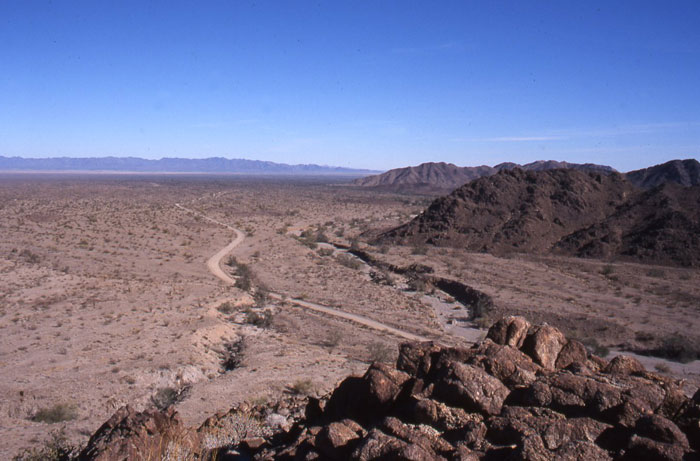
^Chuckwalla Valley view, Riverside County, California.
First Solar, Inc. (based in Tempe, Arizona) and Southern California Edison (SCE) today announced agreements to build two large-scale solar power projects in Riverside and San Bernardino counties in southern California. First Solar will construct the two solar facilities, using thin-film photovoltaic solar modules. The projects are the 250 megawatt (maximum capacity) Desert Sunlight project near Desert Center, Calif., and the 300 megawatt (maximum capacity) Stateline project in northeastern San Bernardino County (apparently OptiSolar's former project in Ivanpah Valley east of the I-15 highway and north of Nipton, California. This is along the northern boundary of Mojave National Preserve). Pending transmission upgrades and governmental permits, construction is scheduled to begin in 2012 for Desert Sunlight and 2013 for Stateline. Both projects are expected to be completed in 2015.
A modern-day land rush is under way in the deserts of Arizona and the Southwest as public utilities and speculators vie for vast tracts of public and private land on which to build massive solar-power plants. Potential buyers include utilities such as Sempra Energy, First Solar, and PG&E; investment banker Goldman Sachs; Spanish, Israeli and German solar firms; and speculators.
Solana Generating Station near Gila Bend and Starwood Solar 1 plant in the Harquahala Valley each has tied up about 2,000 acres. The Duke Energy project near the Palo Verde Nuclear Generating Station has tied up about 3,000 acres. Near Kingman, Mohave Sun Power is negotiating to buy 4,000 acres for a solar-power plant, and Albiasa Solar has tied up 1,400 acres. These are on private land, but since the Bureau of Land Management opened its lands to solar-power development in 2007, more than 117 claims have been staked for more than 1.5 million acres of federal land in Arizona, California and Nevada deserts. That includes 37 applications for a total of 720,000 acres in Arizona. Applicants include New Dawn Energy, seeking three parcels totaling 224,000 acres in Maricopa and La Paz counties, and Pacific Solar Investments Inc., which has three applications pending for 77,000 acres near Salome and Quartzsite.
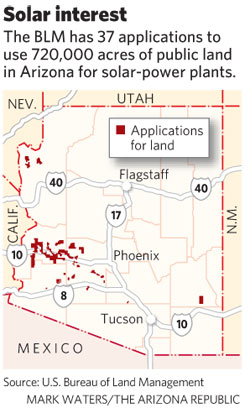 Meanwhile, in California, the U.S. Department of the Interior is investigating cases in which the applications are being bought and sold for a profit.
Meanwhile, in California, the U.S. Department of the Interior is investigating cases in which the applications are being bought and sold for a profit.
"Theoretically, they are not supposed to have any value because they have not yet been approved," said Jan Bedrosian, deputy director of external affairs for the BLM in California.
The investigation centers on a $400 million acquisition in March of California's OptiSolar by Tempe-based First Solar Inc. Although OptiSolar is a manufacturer of solar panels, the deal included only the company's pipeline of unfinished solar-power plants and applications for 136,000 acres of BLM land in southern California. In Arizona, OptiSolar has applications pending to use 14,000 acres for three plants.
First Solar spokesman Alan Bernheimer acknowledged the applications were an important part of the transaction, which he said was "completely aboveboard."
Story at First Solar's website >>here, and in the Riverside Press-Enterprise >>here.
See also the story about the Land Rush for solar in the Arizona Republic >>here.
See our story about Desert Center abd the Chuckwalla Valley >>here.
August 13, 2009
"Renewable" Energy Transmission Lines Map
The California state Renewable Energy Transmission Initiative released its latest report suggesting possible routes for new transmission lines to carry electricity from wind farms and solar plants. Building all the lines would cost $15.7 billion, but not all of them would need to be built.
"We're transforming the way we power the economy. That's an audacious thing to do," said Carl Zichella, regional director for the Sierra Club, who is working on the transmission initiative. "And there are some people whose point of view is limited to their backyards. I think they have a valid point of view, but they don't get a veto."
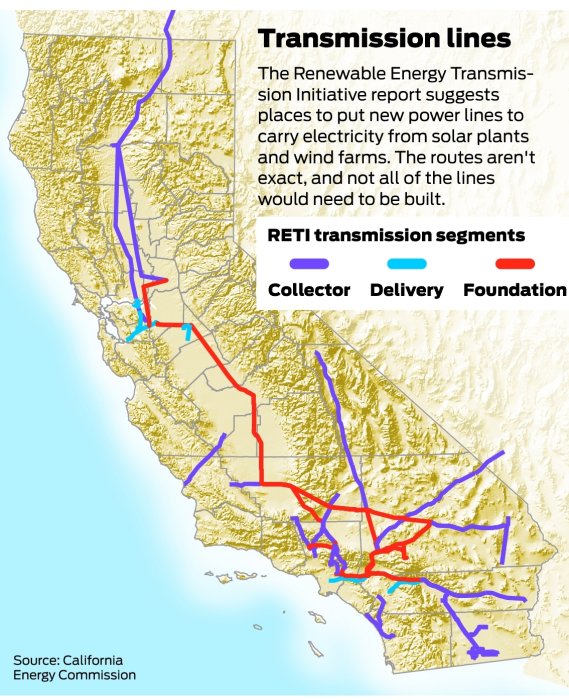
See the story in the San Francisco Chronicle >>here.
California Energy Commission - RETI >>here.
August 6, 2009
Explosion Dangers of Solar Thermal
With the plan by Solar Millennium to build a large solar thermal energy plant next to the town of Amargosa Valley, Nevada, residents should be aware of the potential dangers of these industrial developments so close to residences, schools, and farms. A major explosion and fire at the first Solar Electric Generating Station (SEGS 1), in Daggett, California happened in 1999. A fire burned out of control at the Sunray Inc. solar plant after a massive explosion shook the surrounding area. Some residents came over to see what had happened, including local news photographer Lara Hartley. 900,000 gallons of a mineral oil burned, and the ruins of the plant continued to smolder after 14 hours.
See the amazing photos taken by Lara Hartley >>here.
July 27, 2009
Steens Mountains, Oregon Wind and Transmission Projects
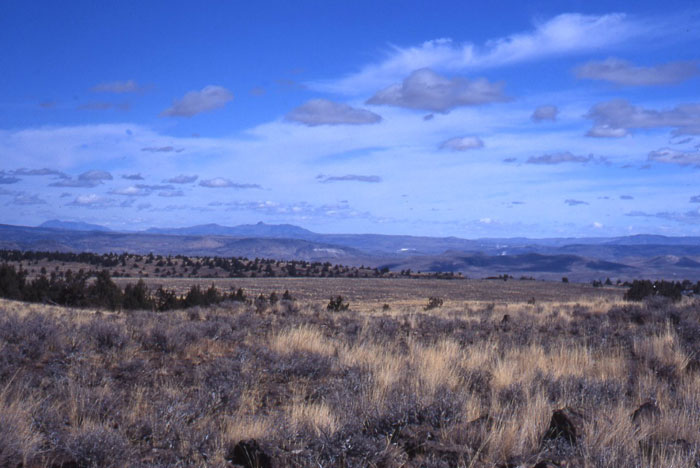
The Bureau of Land Management announced plans to prepare an Environmental Impact Statement and possible Resource Management Plan Amendments for the North Steens Transmission Line Project in Harney County, OR. The project will involve BLM-administered public lands, private lands, and lands administered by the
U.S. Fish and Wildlife Service, Malheur National Wildlife Refuge. In December 2008, Harney Electric Cooperative filed a preliminary application for a right-of-way with the BLM for construction, operation, maintenance, and termination of a 29-mile long 230 kilovolt (kV) transmission line that would connect the Echanis Wind Energy Project with Harney Electric Cooperative's existing transmission system near Diamond Junction, Oregon. The application was subsequently assigned to Echanis, LLC, a subsidiary of Columbia Energy Partners, LLC, who proposes to fund, construct, and oversee the initial development and commissioning of the project. Upon commission, the transmission line would be deeded to Harney Electric Cooperative for
long-term operation and maintenance as part of their electric transmission and distribution system in southeast Oregon and northern Nevada.
The purpose of the project would be to transmit up to approximately 103.5 megawatts (MW) of renewable energy from the Echanis Wind Energy Project to target service areas in the Pacific Northwest. The proposed transmission project would also be designed with additional capacity to conduct power generated from other possible renewable energy generation facilities that may be planned in the
future. The proposed transmission line would begin at the Echanis Wind Energy Project southeast of Diamond, Oregon, on private lands, and end at Harney Electric Cooperative's existing 115 kilovolt (kV) line near Diamond Junction. The proposed line would cross approximately 19 miles of private land, 9 miles of public land administered by the BLM, and 1.3 miles of land on the Malheur National Wildlife Refuge, including a span over the Blitzen Valley of approximately 1,800 feet. Echanis, LLC, proposes to utilize steel structures approximately 90 to 140 feet in height with average spans between towers of 700 feet. The proposed right-of-way would be 150 feet wide. Additional temporary work space would also be required
during construction for material storage, line tensioning sites, and construction access.
The Echanis Wind Energy Project is to be located entirely within private lands. A conditional use permit for the wind project was issued to Columbia Energy Partners by Harney County in April 2007. Although wind testing and project feasibility studies are currently ongoing on private, State, and Federal lands in several areas throughout Harney County, the Echanis project is the only wind energy project approved for development, to date, by Harney County or any other jurisdiction.
Currently there are no transmission facilities available in the Diamond/North Steens area to transport electrical power produced from the Echanis Wind Energy Project to the existing transmission grid.
At present, the BLM has identified the following preliminary issues: sage-grouse, migratory birds, recreation, local and regional social/economic conditions,
visual resource management, and special management areas including the
Malheur National Wildlife Refuge and the Steens Mountain Cooperative Management and Protection Area.
The BLM will announce public scoping meetings on the BLM Web site
(http://www.blm.gov/or/districts/burns) at least 15 days prior to each meeting. Public meetings will tentatively be held in Burns, Bend, Diamond, and Frenchglen, Oregon, and other communities if the interest warrants. You may submit comments to the North Steens Transmission Line Project Lead, BLM Burns District Office, 28910 Highway 20 West, Hines, Oregon 97738; Fax (541) 573-4411; or e-mail: OR_Burns_NS_Transmission_Line_EIS@blm.gov.
From: Federal Register: July 27, 2009 (Volume 74, Number 142), Notices: Page 37052-3705, wais.access.gpo.gov, DOCID:fr27jy09-69.
July 24, 2009
Solar Farm Proposed near Crescent Dunes, Tonopah, Nevada
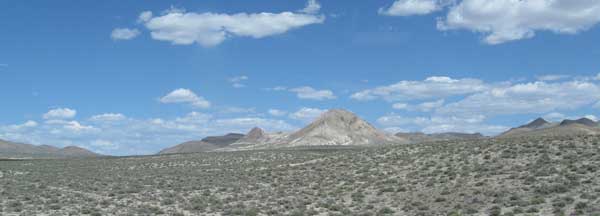
Nye County commissioners went on the record in support of the Solar Reserve solar power project near Crescent Dunes, 20 miles northwest of Tonopah, the latest proposed site in the face of continuing objections from Nellis Air Force Base officials.
Solar Reserve, based in Santa Monica, California, first proposed a site near Mud Lake for a 100 megawatt solar power project, south of the Tonopah Airport. The U.S. Air Force objected, saying it would interfere with radar at Nellis Air Force Base.
When the Air Force said a site at Peavine Creek in Big Smoky Valley could have the potential to interfere with their training routes, the company settled on the Crescent Dunes location, on Pole Line Road near the former Anaconda mine.
Solar Reserve commissioned a study by Aerospace Corp., a contractor with a lot of experience dealing with the U.S. Department of Defense, to study possible effects their project would have on radio frequency, microwave and infrared thermal emissions, electromagnetic interference and radar related issues. The Air Force said there were no more concerns over thermal and electromagnetic emissions at Crescent Dunes but remained concerned about radar interference.
Solar Reserve would use a series of mirrors, called heliostats, to focus solar power on a receiver atop a 650-foot tower that heats molten salt to over 1,000 degrees, where power can be transferred into a thermal storage tank and stored. The Crescent Dunes site is 25 miles from the boundary of the Tonopah Test Range and is shielded by mountains 2,000 feet above the site.
While many companies are looking to locate solar power projects in Amargosa Valley, Solar Reserve prefers the Tonopah area because it will be easier to connect into the NV Energy system. They hope to begin construction by the end of 2010 to capitalize on the economic stimulus package, much like Solar Millenium, which has plans for two 250-megawatt solar power plants in Amargosa Valley.
Story in Pahrump Valley Times >>here.
July 24, 2009
BLM Auctions Geothermal Leases in Nevada
 An auction of 323,222 acres of public land by the Bureau of Land Management (BLM) for geothermal leases, including parcels in Nye and Esmeralda counties, raised $8.9 million. But under Senate Bill 1, passed by the Nevada Legislature during a one-day special session last December, counties won't receive 25 percent of the proceeds. The state will collect 75 percent, the BLM the remaining 25 percent.
An auction of 323,222 acres of public land by the Bureau of Land Management (BLM) for geothermal leases, including parcels in Nye and Esmeralda counties, raised $8.9 million. But under Senate Bill 1, passed by the Nevada Legislature during a one-day special session last December, counties won't receive 25 percent of the proceeds. The state will collect 75 percent, the BLM the remaining 25 percent.
Geoglobal Energy LLC of Chevy Chase, Md., was the successful bidder on five parcels totaling 19,163 acres in the northwestern corner of Nye County or jointly in Nye and Mineral counties. Those parcels were auctioned for $458,305, of which $114,576 would have previously gone to the county. Rampower Inc. of Reno was the successful bidder on six parcels totaling 29,900 acres in Esmeralda County that brought in $312,583. Bid prices were in the range of $5 to $32.50 per acre for Nye and Esmeralda County parcels. But elsewhere, Ormat Nevada Inc. paid $3,800 per acre for one parcel. The highest price for a single parcel was $2.65 million by TGP Development Co. for 5,045 acres.
Many of the leases -- 39 of the 108 parcels accounting for 116,313 of the 323,222 acres statewide -- were in the geothermal hotbed of Churchill and Pershing counties.
But the last three geothermal lease sales show companies are exploring the potential farther south. During an August 2007 auction of geothermal leases, Nye County received $561,000 as its one-quarter share of the proceeds. During that auction, Silver State Geothermal of Santa Monica, Calif., and Raser Power Systems of Salt Lake City, Utah, bid on parcels in northern Big Smoky Valley near the Lander County line. In August 2008, Rampower bid on 14,144 acres in Esmeralda County. Sierra Geothermal Power Inc. of Olympia, Wash., bid on another 3,737 acres. Magma Energy of Reno bid on a 2,560-acre parcel in Esmeralda County and a 2,560-acre parcel straddling Nye and Mineral counties. Dan Schophet, executive vice-president of Rampower said his company now has five lease blocks in Esmeralda County in Clayton Valley, near the hot springs at Alkali just north of Goldfield.
Geological work done about 20 years ago pointed to geothermal potential farther west in Fish Lake Valley, Schophet said. Acquiring the lease is only the first step. Companies like Rampower then have to go through the environmental permitting, which can take six to 18 months. The companies also have to do some exploratory drilling, to verify the temperatures and depths are at a level suitable for commercial development, he said.
Geothermal energy accounts for 17 percent of the electricity generated from renewable sources in the U.S., according to the BLM. The BLM manages 560 geothermal leases, with 58 already producing 1,275 megawatts of power on public lands. A programmatic environmental impact statement on geothermal energy opened 111 million acres of BLM land for leasing and 97 million acres of National Forest land, spurring the demand. The EIS forecasts a potential for 5,540 megawatts of new power from additional geothermal plants by 2015.
Story in Pahrump Valley Times >>here.
July 23, 2009
Amargosa Concentrated Solar Thermal Plan Available
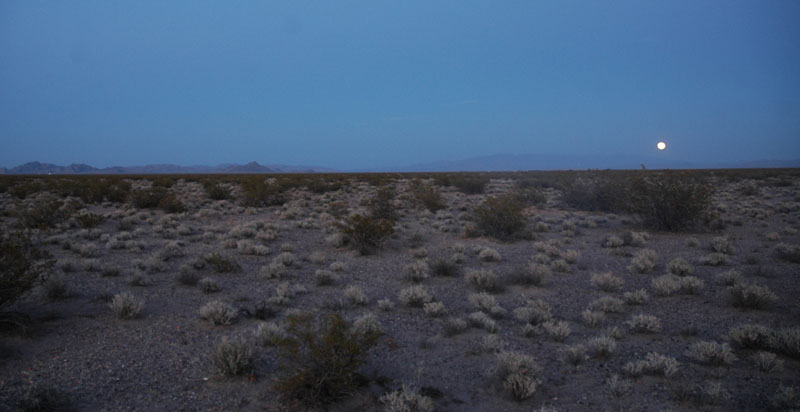
Solar Millennium has its Plan of Development out for public view. Still wishing to build a wet-cooled plant next to several dairies and alfalfa farmers, Solar Millennium now has a dry-cooled option in case it cannot secure enough water rights.
Basin and Range Watch called the Nevada State Engineer's Office about water issues in this arid basin. They told us Amargosa Valley is "a mess." The Nevada State Engineer is concerned with a transfer of 2 acre-feet, let alone 3,000 acre-feet, which is the proposal by Solar Millennium for its power plant. The state is continuing to uphold its 25-mile regulation zone around Ash Meadows National Wildlife Refuge as well. Another renewable company is trying to build a pipeline from springs at Johnnie, near Crystal, 20 miles away in a separate basin from the Amargosa area, to get its water. The new Amargosa Solar Study Area, designated by the Bureau of Land Management and Department of Energy to expedite renewable energy development, is all within the Amargosa Valley Farm Region, a place frought with problems of scarce water resources, we were told.
The BLM Las Vegas Field Office link to Solar Millennium's Plan of Development is to a large pdf >>here.
HOME....page 1....page 2....page 3....page 5....page 6....page 7
